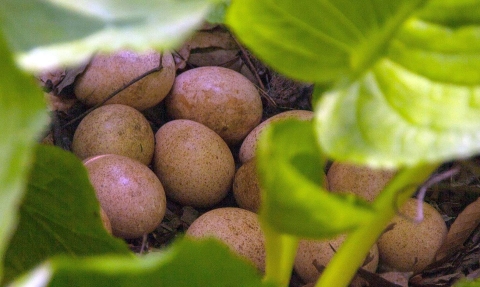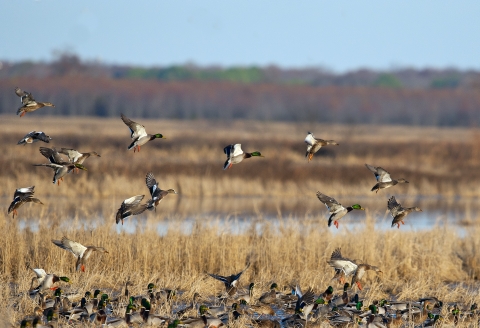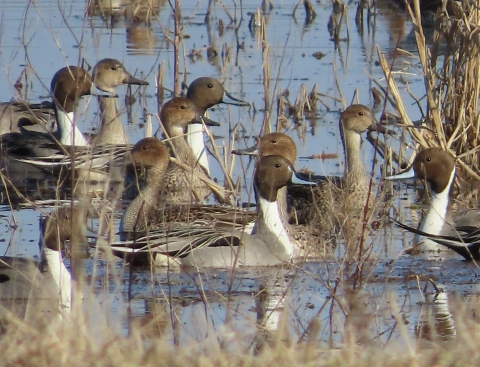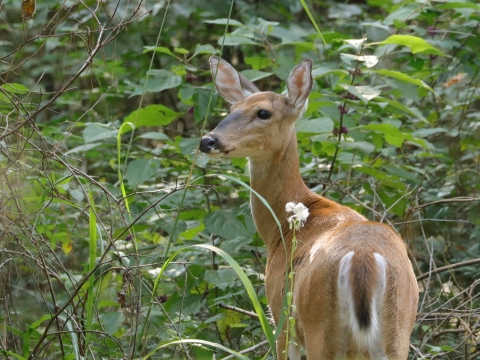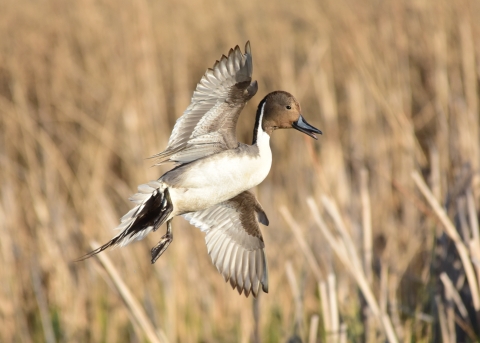Seasons of Wildlife
Spring
Hundreds of thousands of migratory waterfowl and other birds pass through Bald Knob NWR on their annual migration to their northern breeding grounds. As the temperatures begin to rise, Bald Knob provides thousands of acres of habitat for food, cover, and sanctuary. While much of the winter forage has been consumed by the birds that overwintered and through natural decomposition, a new food source is becoming available.
As the temperature warms, invertebrates begin to emerge from the decomposing vegetation and below the muddy surface. These invertebrates are a vital food source for the birds to continue on and complete their migration. Bats can be seen foraging on flying insects in the twilight. The resident bald eagles are tending to their nests. Cooperative farming practices begin to set the table for the next fall's harvest. By the end of spring, deer fawns are hitting the ground, resident song birds, wood ducks, and turkeys are nesting and sitting on their eggs, and the landscape is transformed from a dull gray to a vibrant green. Food is once again plentiful for the wildlife, and deer begin browsing on the tender vegetation that is beginning to sprout.
Summer
With nearly all of the migratory birds now long gone, the growing season at Bald Knob is in full swing. With moist soil fields full of lush green vegetation and cooperative farming crops on their way to producing future forage for waterfowl, summer is the peak time of growth. Turkey poults are following the hens around and scratching in the leaf litter, deer fawns are being tended to does, and the bucks are just starting to regrow their velvety antlers. Resident song birds have hatched out from their eggs and many are in full flight. Rains become less frequent, temperatures are high, and in many years we are on the cusp of near drought-like conditions.
Near the end of the summer, the first migratory shorebirds begin to arrive and take advantage of the mudflats that are managed for at the refuge. Cooperative farming crops are ready for harvest. Blue-winged teal start to show up in mid September, and unless we've had an unexpected amount of rainfall, will continue their flight towards the gulf coast and beyond.
Fall
The first cool front arrives and is a welcome respite from the long hot summer! These cool fronts will hopefully bring some much need precipitation. The fall harvest of cooperative crops is near completion, with plenty left behind to provide forage for the migratory waterfowl that will soon arrive. As the fall harvest is completed, mangers begin flooding the fields from rainfall that has been captured or from surface water redirected from the Little Red River. The deer have shed their reddish summer coats for a more suitable brown winter coat, and the bucks have lost their velvet. As fall turns into winter, more and more waterfowl begin to arrive as well as the raptors; hawks, and eagles are much more prevalent now.
Winter
As fall gives way to the winter, the rains have hopefully flooded much of the habitat for the hundreds of thousand of waterfowl that show up annually at Bald Knob NWR. The crop that was left behind for the waterfowl is now being utilized, and the ducks and geese are getting the much needed fat and calories to survive through the coldest part of the year. Winter forage is critical for them to be in the best condition to make their journey back to the north in the spring.
If the winter is mild, many of these birds may spend a majority of the winter here. However, if the winter is more severe, the birds will simply move on to the south to take advantage of the warmer conditions and available food sources. Winter can be a tough season for the wildlife. Deer browse is scarce, and towards the end of the winter food can be hard to come by, but hopefully they have faired well enough to carry them through this hard time, for spring is right around the corner.
Featured Species
Bald Knob National Wildlife Refuge (NWR) supports a tremendous array of wildlife species. Visitors may see large mammals such as white-tailed deer year round, or a wide range of smaller species such as reptiles and amphibians in the warmer months.
Waterfowl and other bird life are abundant. Since the refuge was established to benefit waterfowl, they are the most numerous type of bird species found at Bald Knob NWR. During the late fall and through winter, large concentrations of blue, snow, Canada, and white fronted geese can be seen feeding in the stubble leftover from farming. Mallards, pintails, blue and green wing teal, and wood ducks can be found swimming and feeding in the wetter areas.
Bald Knob NWR is the largest staging area in Arkansas for Northern Pintails. At one time, there were over 200,000 recorded in a single day. Visitors are likely to see them during the fall migration.
During the winter months, visitors are also likely to observe bald eagles. They can be seen perched high above the refuge or flying overhead. At times there can be as many as twenty bald eagles in a given area.

